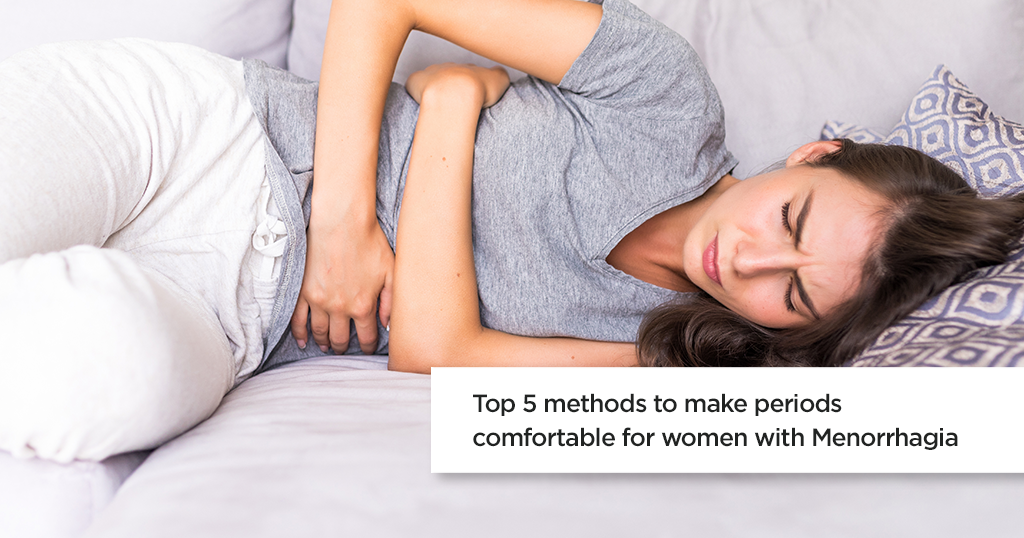Menorrhagia: Symptoms, Causes and 5 Methods to Make Periods Comfortable


Menorrhagia is described as heavy bleeding during menstruation that occurs once every 28 days. The blood flow is continuous, the clots are larger, and women may have to change their pads 2-3 times a day. The heavy bleeding may be due to varied reasons like hormonal changes etc. Profuse bleeding may lead to medical conditions, such as anemia, fatigue and stress.
Signs and symptoms
- Sanitary pads are heavily soaked in the blood due to heavy bleeding [ 1 or more tampons or pads every hour for many hours]
- Menses which last for more than 7 days
- Blood flow may be accompanied by large clots
- Unable to do normal activities due to bleeding
- Feeling tired with breathlessness or feel exhausted
- Low in energy
- Constant pain in the lower abdomen
Causes of Menorrhagia
Uterine and hormonal disorders are significant causes of Menorrhagia among many others.
Other related causes include-
- Growth of tumors in the uterus which is not related to cancer
- Uterine or cervical cancer
- Certain unsuitable birth control measures
- Problems concerning pregnancy- including miscarriage or an ectopic pregnancy, or in situations where the fertilized egg gets implanted outside the uterus.
- Irregular bleeding pattern
- Underlying kidney, liver or thyroid issues
- Diseases in the pelvic region (or infection in the reproductive area)
- Consumption of drugs like aspirin
- Perimenopause- an early transition towards menopause
- Childbirth
- Presence of fibroids or polyps in the womb muscles or lining.
Methods to Make Periods Comfortable for Women with Menorrhagia –
- Menstrual cups do not reduce the blood flow but can minimize bathroom visits.
They are made of silicone and collect the menstrual blood when inserted in the vaginal canal. They are not painful and are quite easy to fit.
Menstrual cups are vagina friendly and retain the moisture within the vagina.
A Menstrual cup is a great way of reducing tampons and pads usage as they can cause irritation. It can be worn for 12 hours and one can work around with the cup as it will not cause any disturbance to the woman wearing it.
They aid in leakage prevention and are equally effective like pads. However, women may find menstrual cup insertion cumbersome, with fitting and maintenance issues. Sometimes it may irritate if not cleaned properly.
- Heating pads
These pads provide relief from pain and cramping during periods. The warmth from the heating pad can provide muscular relaxation for soothing the muscles. The heat pads can improve blood circulation, relieving menstrual pain or cramp. Cold therapy also acts similarly. Cold compressors can be used for reducing cramps or pain. You can use any therapy which is suitable for your body.
3. Rest at regular intervals
Taking proper rest during periods can help relax both the mind and body, promoting relaxation and blood circulation.
- Exercise and food
Exercise, such as yoga, can help reduce stress and help in controlling the blood flow. Exercise releases good hormones, such as endorphins, which make a person feel at ease and helps in providing relief from muscle spasms or cramps, thus reducing the pain during menstruation. Vitamin D and iron supplements help in restoring the blood loss during periods. Omega-3 fatty acids obtained from fish are known to reduce inflammation while reducing pain during menstruation. Consuming chamomile tea during menstruation may help reduce spasms.
FAQs
- How long will menorrhagia last?
Menorrhagia refers to heavy bleeding that continues after the 7 days of normal menstruation. The duration of its existence depends on the patient’s health condition.
- When should you go to the hospital for heavy menstrual bleeding?
When symptoms persist despite taking all precuations, it is better to consult your doctor and seek professional help.
Medical tests recommended to diagnose menorrhagia include:
- Pelvic exam: Blood examination to check thyroid and iron levels(for anaemia) and analyze the blood clots (if any)
- Pap test: Scans the cells of the cervix for any abnormal developments.
- Endometrial biopsy : To diagnose any cancers or abnormality present in the uterine tissue
- Ultrasound : To ensure normal functioning of organs, blood vessels and body tissues.
Other tests to understand the period patterns include-
- Sonohysterogram- This is advised to diagnose issues in the uterus lining.
- Hysteroscopy – used to scan or spot the presence of any fibroid, polyps or other similar problems.
- Dilation and curettage (“D&C”)- This is a test-cum-treatment method to control the bleeding. In this test, the patient would be sedated and her uterus lining would be scraped and examined.
- How is menorrhagia treated?
Common methods of treatment include-
- Iron supplements to increase blood levels and avoid anaemia
- Ibuprofen that reduces pain and controls the bleeding
- Birth control measures to sort irregular periods and control bleeding through pills, vaginal rings, or patches
- IUD (Intrauterine contraception) to make periods more regular and decrease bleeding
- Hormone therapy that reduces bleeding
- Use of Desmopressin nasal sprays that helps to stop bleeding in cases of particular bleeding issues
- Antifibrinolytic medication
- Dilation and curettage- The top layer of the uterus lining is removed in this treatment method to control heavy bleeding
- Operative hysteroscopy- involves removal of fibroids, polyps and the uterus lining
- Endometrial ablation or resection- involves complete or partial removal of the uterus lining.
- Hysterectomy – is a method to surgically remove the uterus which will eventually cause permanent menopause.
Conclusion
How long would Menorrhagia last is indeterminate and completely depends on the patient’s medical history. Hence, when heavy bleeding or other symptoms persist after the 7-day menstruating period is done, it is best to consult your gynaecologist and seek professional help. He/she will collect data about your previous menstrual cycle, your period patterns, and ask you to undergo certain pelvic examinations or other relevant diagnoses. They may also enquire about your stress levels, lifestyle habits during menstruation, weight-related issues, or underlying health conditions (if any) as these play a significant role in determining the cause and type for your treatment.
© Copyright 2024. Apollo Hospitals Group. All Rights Reserved.
 +91 8069991061
Book Health Check-up
+91 8069991061
Book Health Check-up







